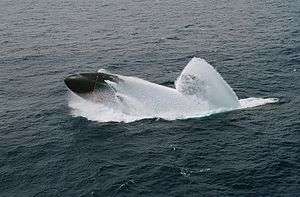Emergency main ballast tank blow
An emergency main ballast tank blow is a procedure used aboard a submarine that forces high-pressure air into its main ballast tanks. The high-pressure air forces ballast water from the tanks, quickly lightening the ship so it can rapidly rise to the surface.

The partial failure of the emergency main ballast tank blow system, caused by icing of strainers in the air lines due to "the high volume of air moving past the strainers at such high velocity [which] would have caused them to cool rapidly," contributed to the loss of USS Thresher in 1963. That accident resulted in substantial redesign of submarine emergency blow systems by the United States Navy: "Part of this initiative was to end the practice of brazing smaller pipes, and to instead start welding and doing X-ray inspection of joints to verify their integrity. It also resulted in changes in designs of the system that blows out the ballast tanks, providing a capability to do so seven times faster than the system used in the USS THRESHER"[1]
References
- "System Failure Case Studies: Submarine Down". NASA Safety Center. NASA. December 2006. Retrieved 23 December 2016.
External links
| Wikimedia Commons has media related to Emergency surfacing. |
- Pohler, CH; Bement, AA; Wilson, DS; Skinner, WA (January 1965). Submarine Main Ballast Tanks – Theory and Method for Refined Structural Design (pdf). Association of Senior Engineers Bureau of Ships Third Annual Technical Symposium. Lay summary – Defense Technical Information Center.